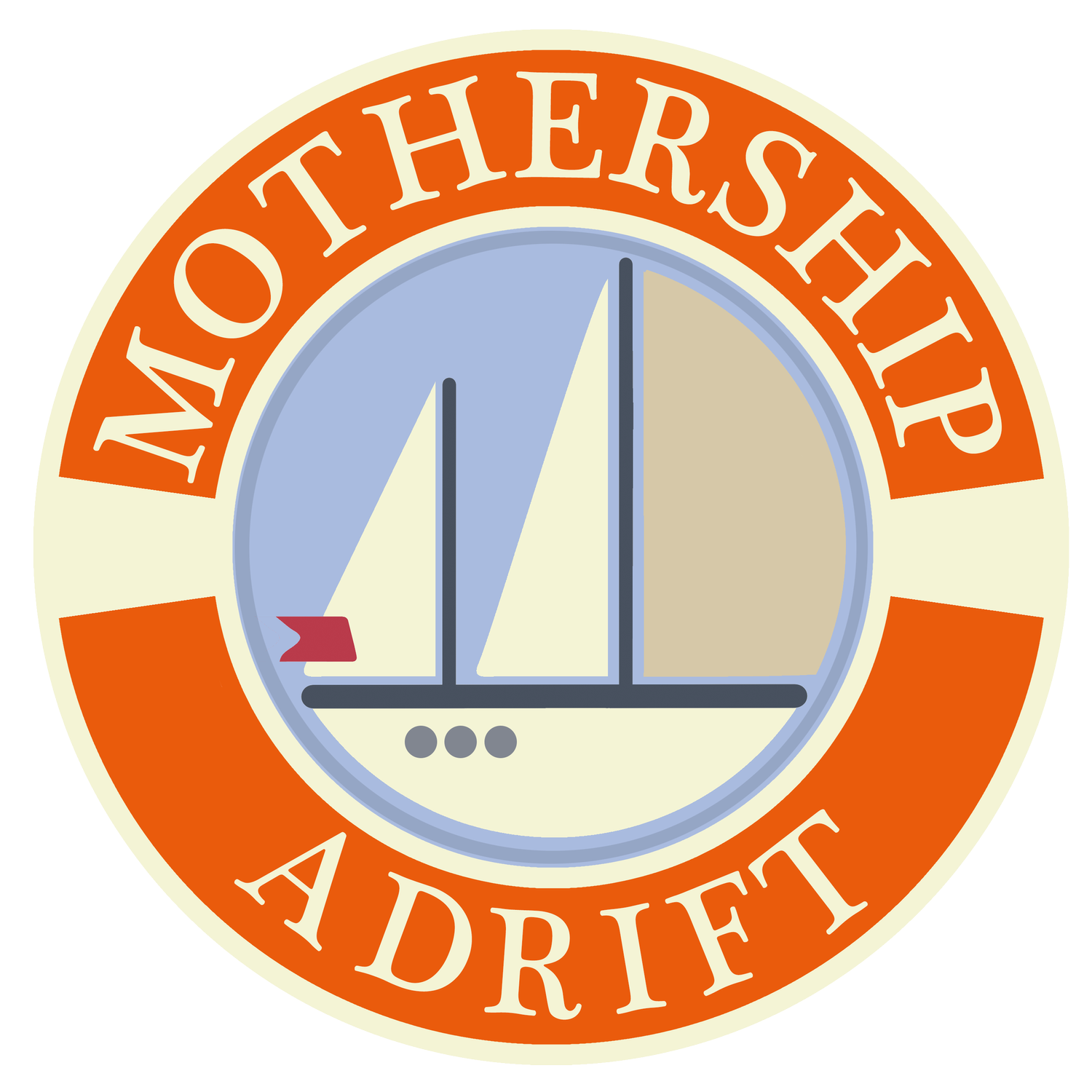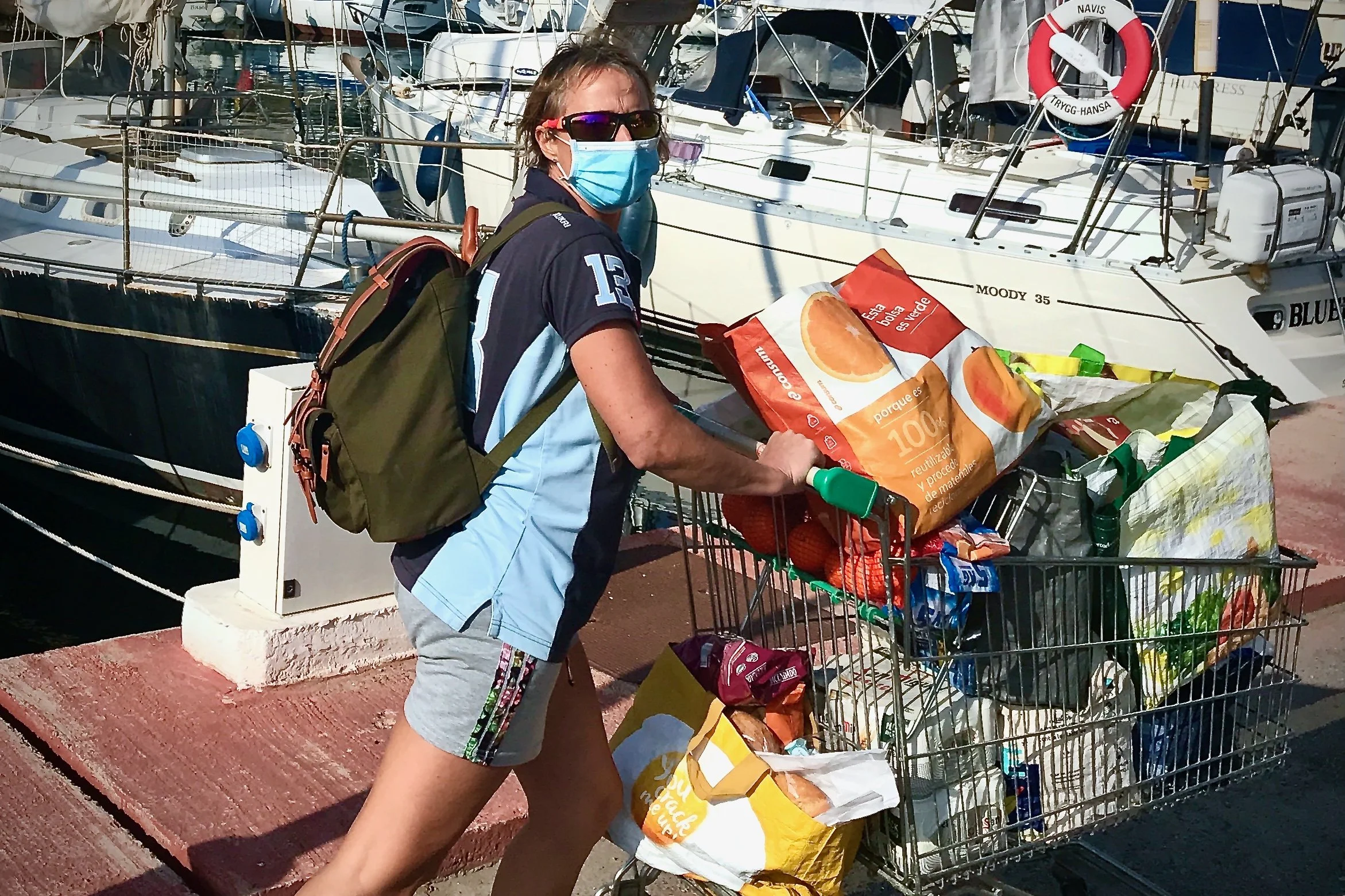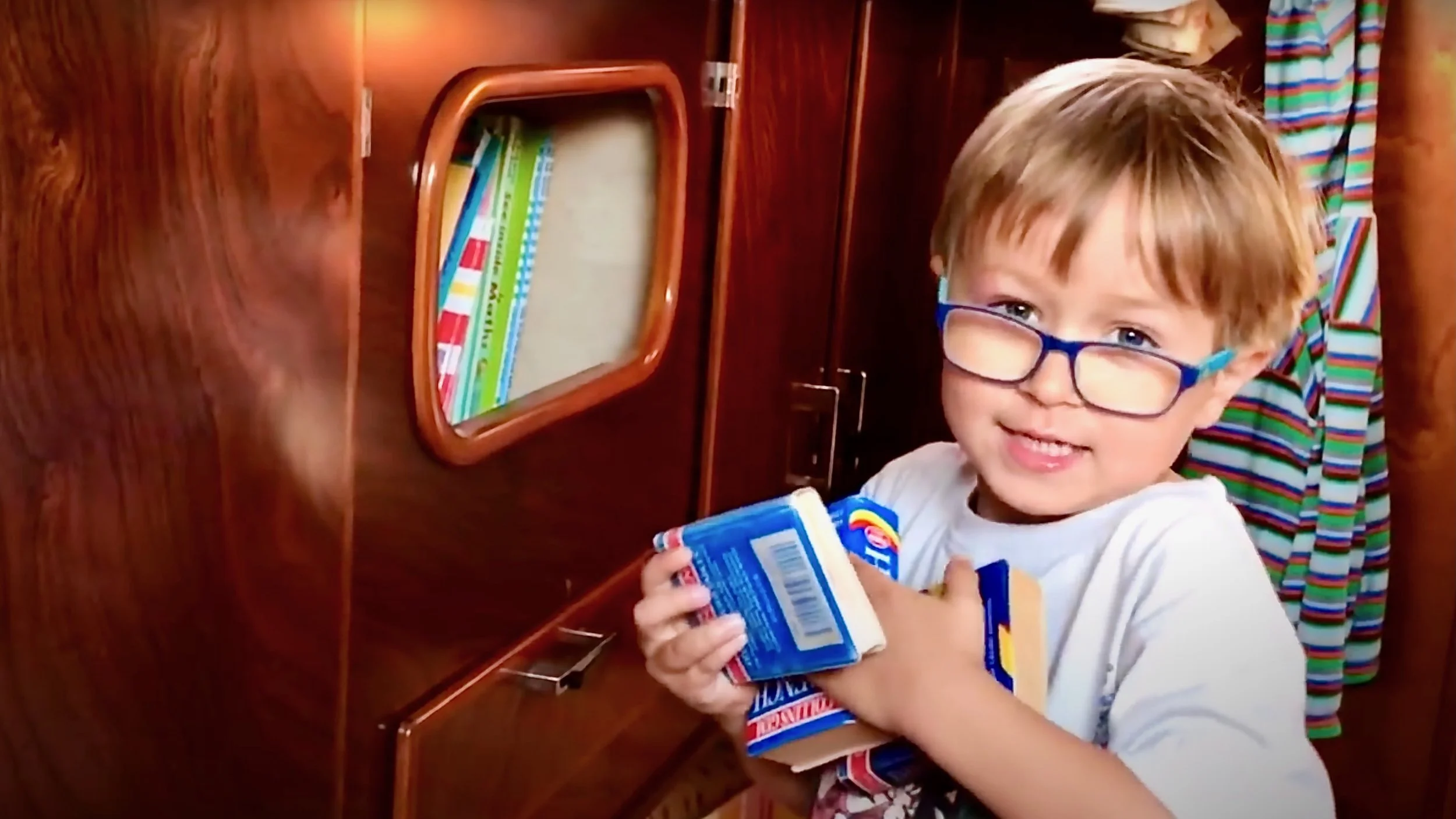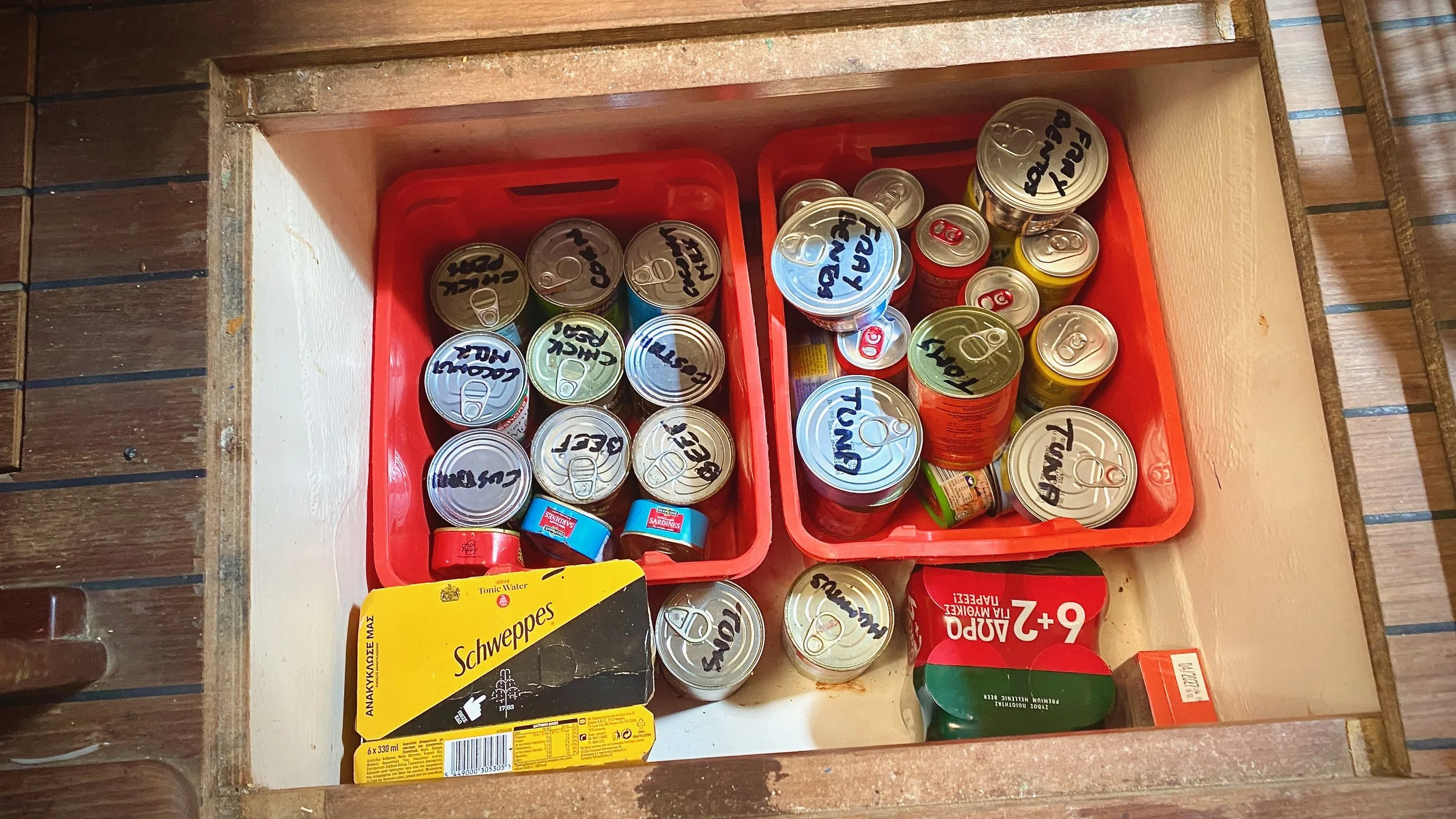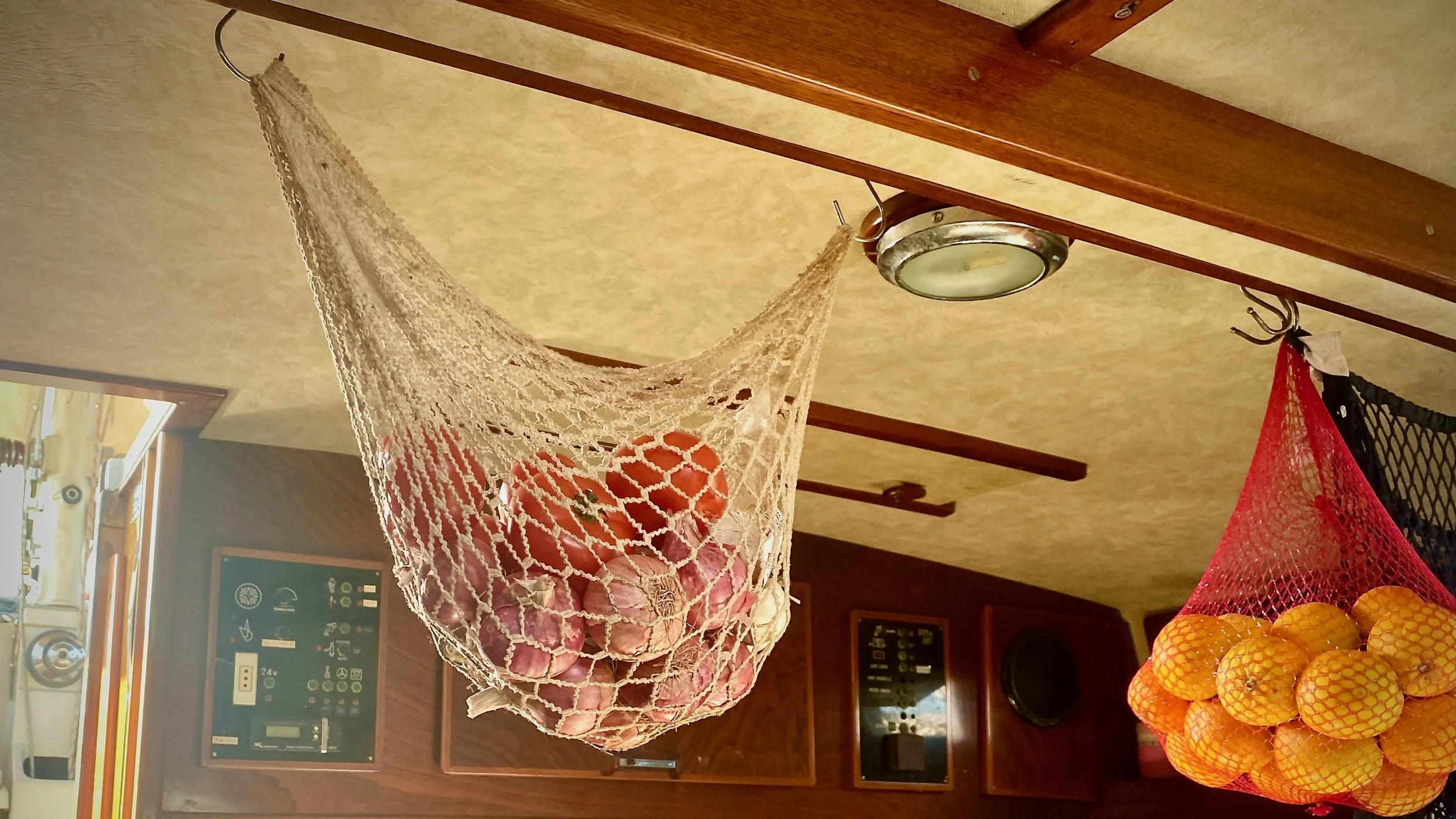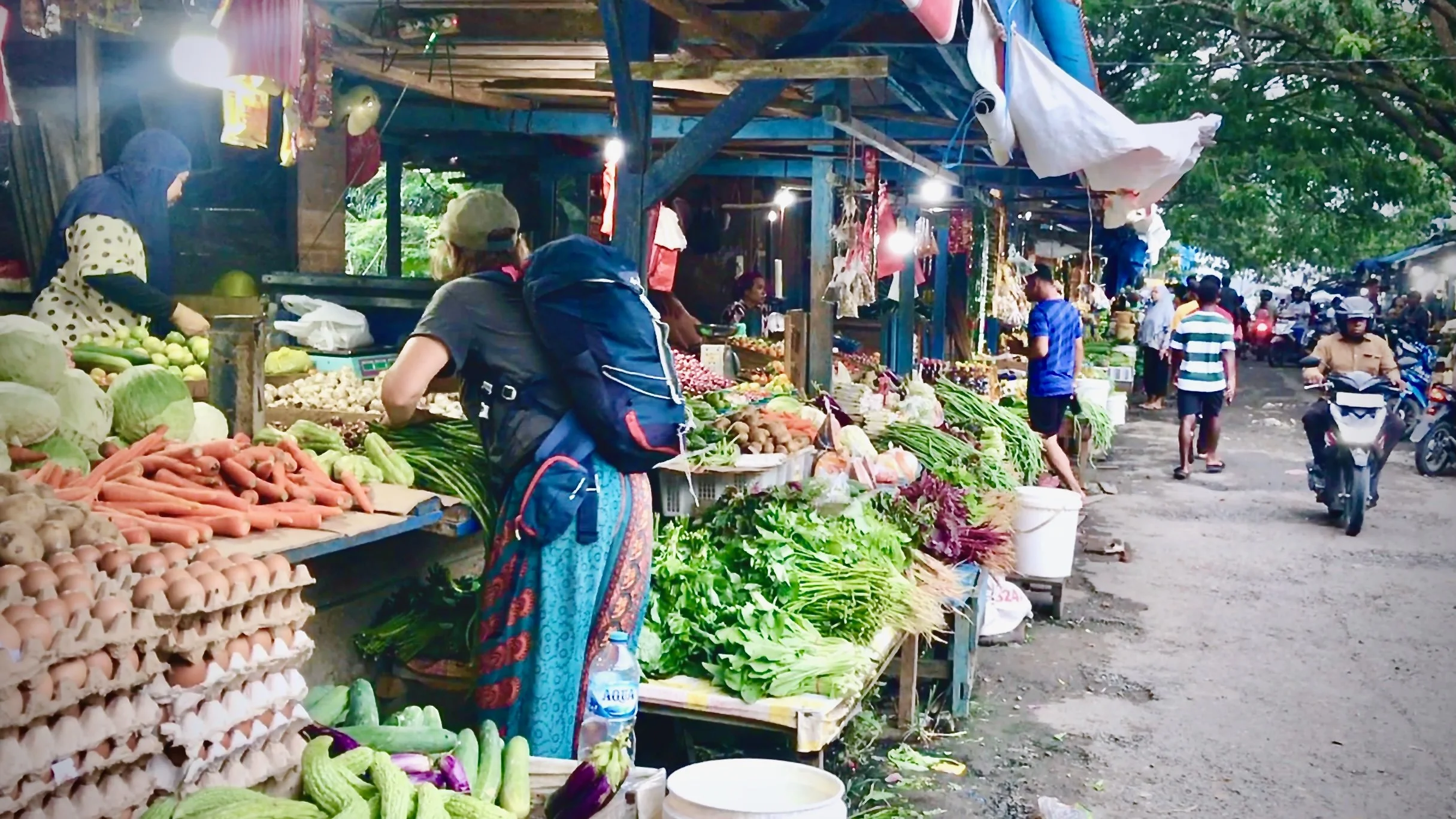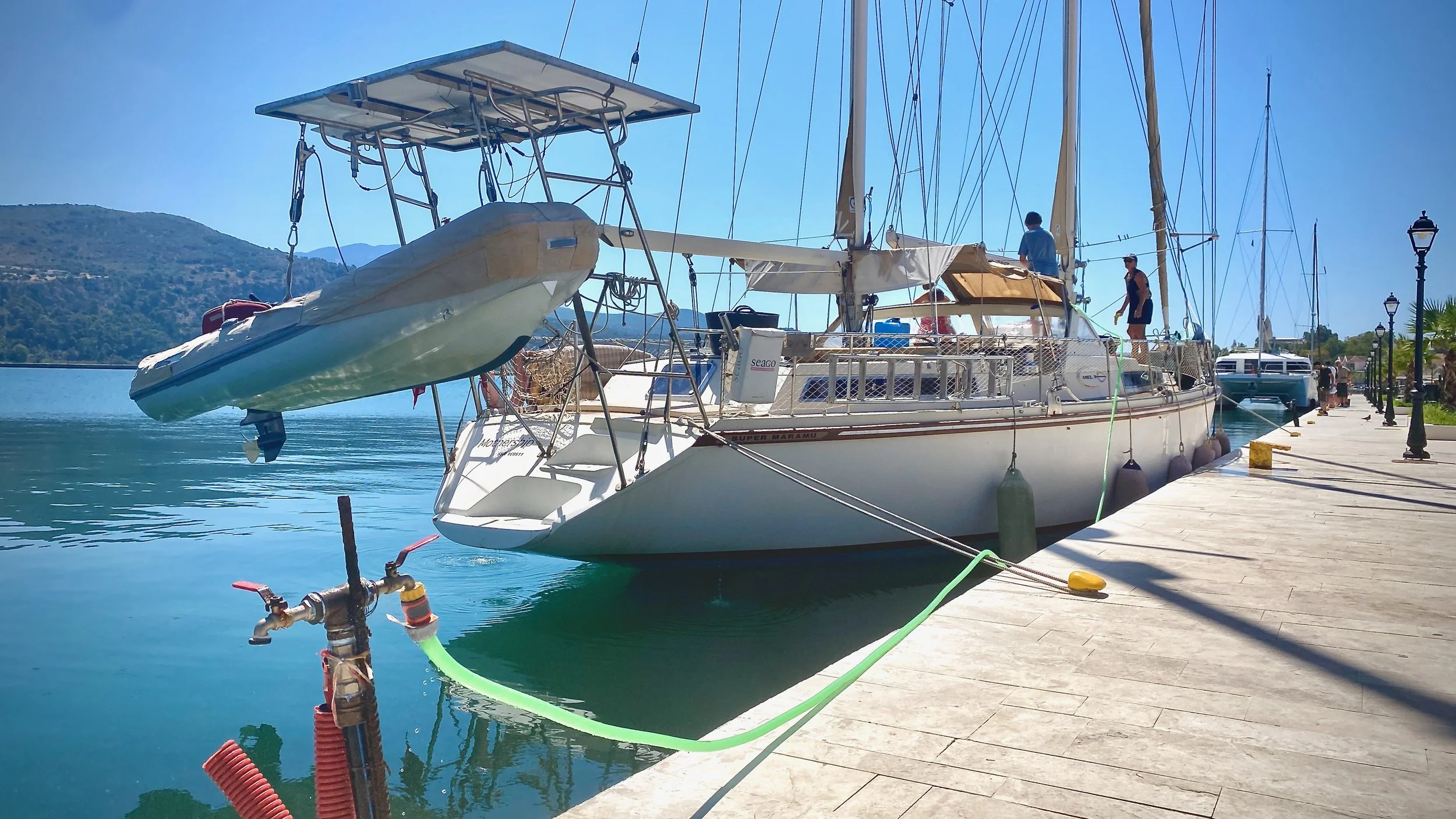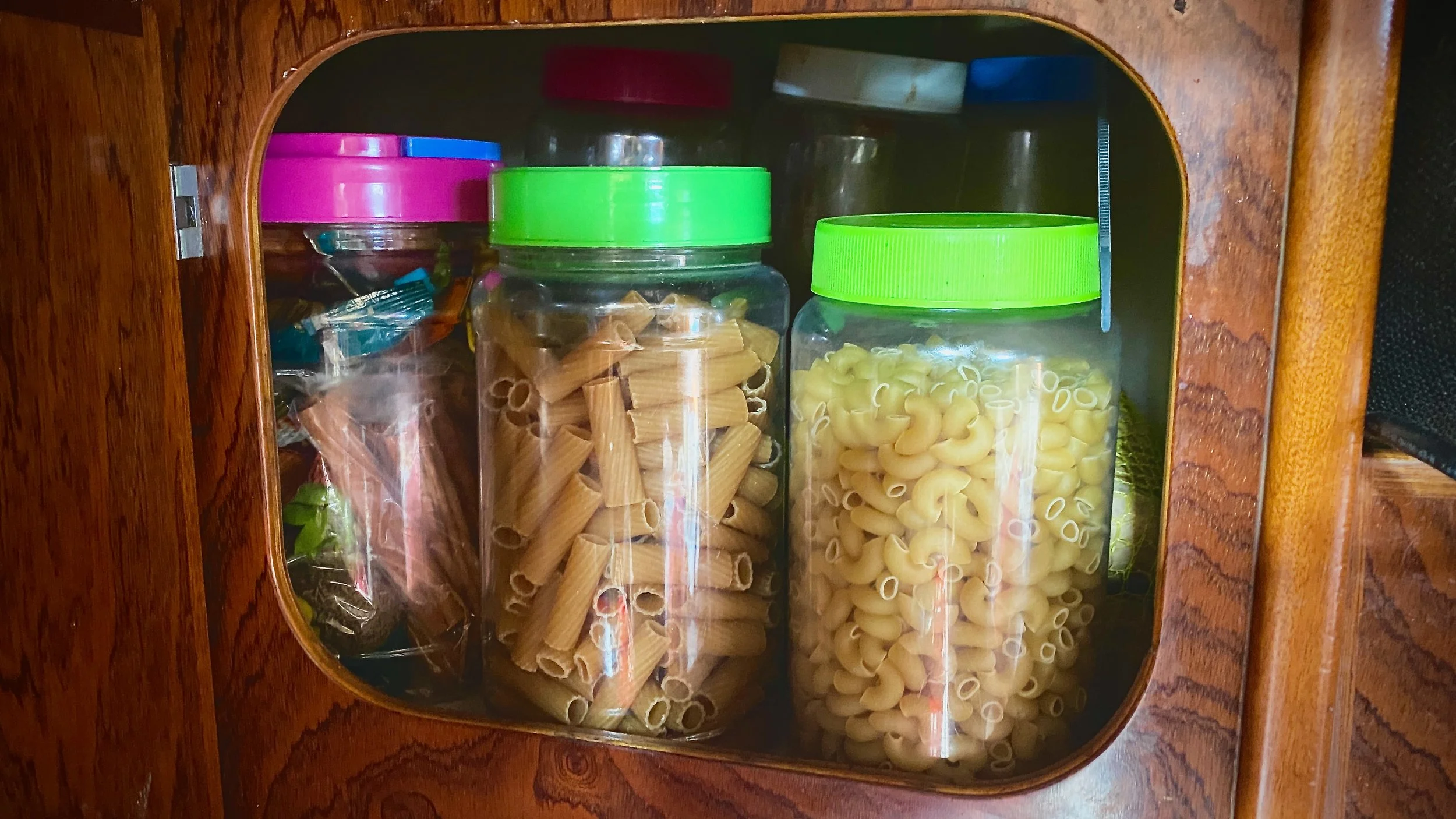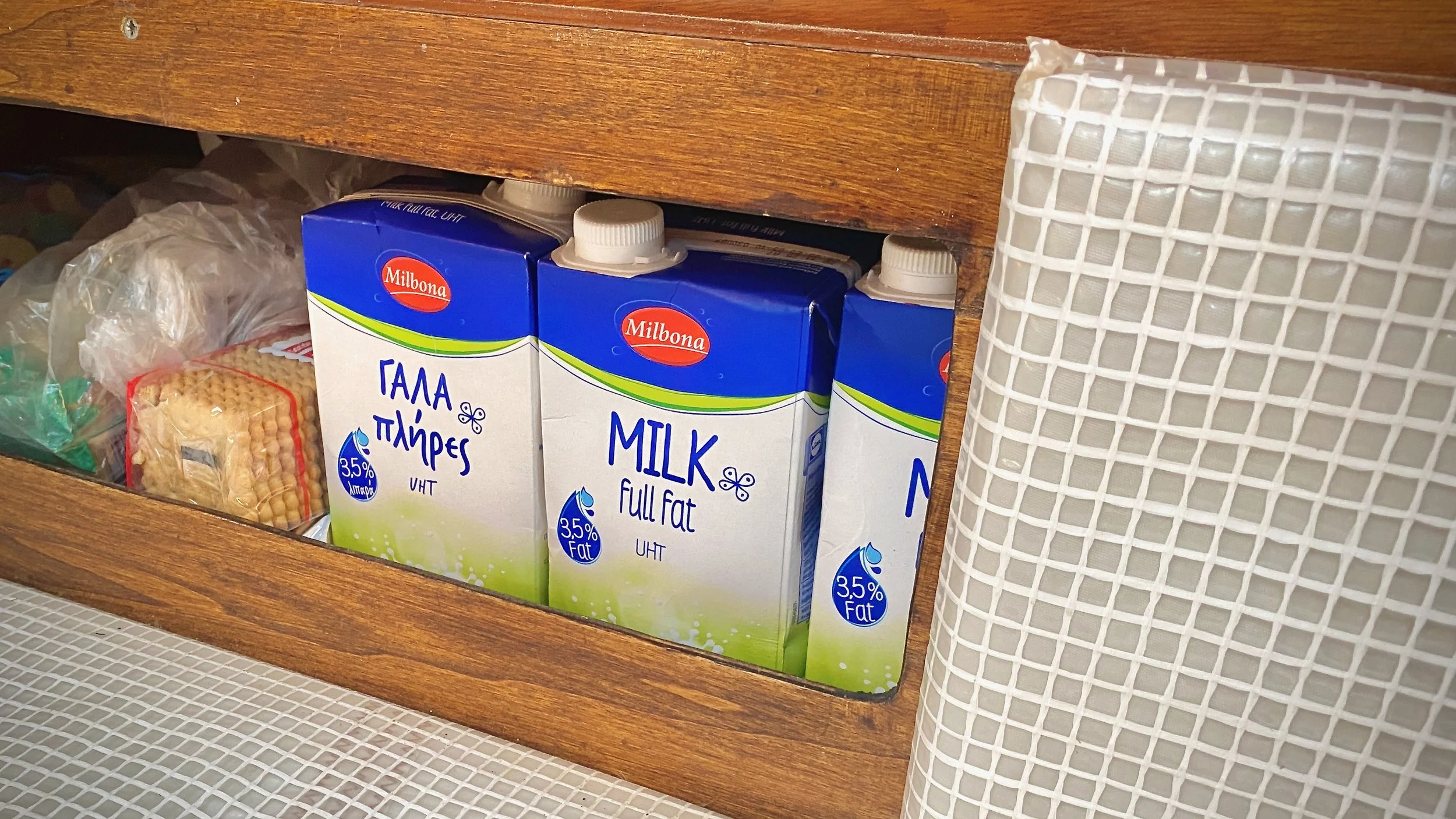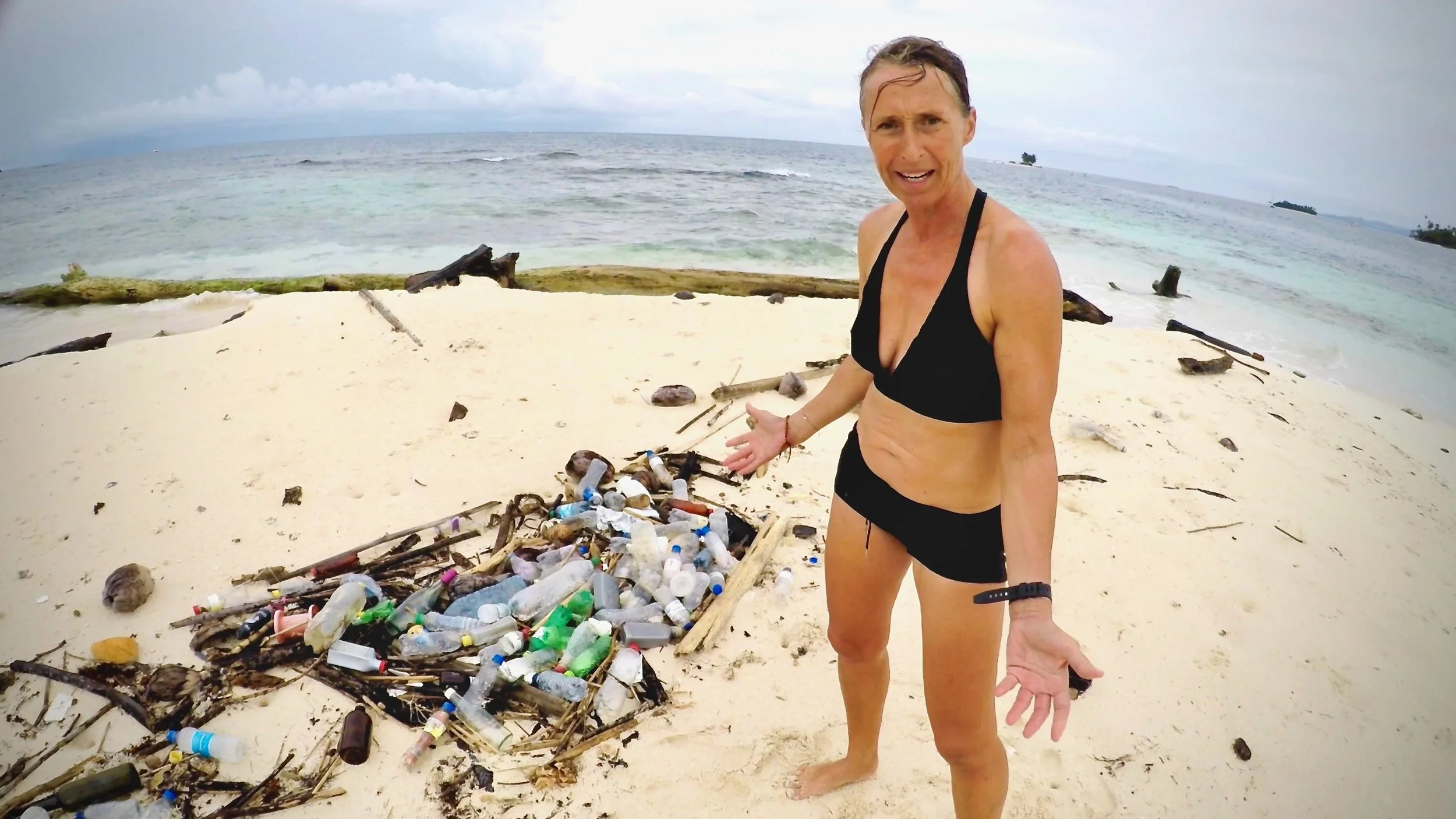Stowing Provisions on a Sailboat
01-04-12
“He who would travel happily must travel light. ”
Irenka pushing a trolley full of provisions back to Mothership
Where the Hell Are the Beans?
Storage doesn’t sell a boat. Not like an extra cabin or a gleaming teak-and-faux-leather interior. Modern boatbuilders are too busy designing floating apartments to worry about where you’re meant to keep 30 tins of chopped tomatoes for an ocean adventure. Open-plan interiors and mood lighting might impress the punters at a boat show, but that cutesy spice rack sat on the open shelf doesn’t look quite so charming when it becomes a glass-and-oregano projectile.
Reality Bites: Provisioning Chaos
So once you’ve clawed your way back aboard with the provisions for your great ocean adventure, the real challenge begins. You need to keep those provisions fresh, bug-free, and easily accessible so you can turn them into something edible long after you’re out of sight of land.
Boat stowage is like playing 4D Tetris. You want onions and you’ve found engine spares. You want curry powder and you’re ankle-deep in wet snorkels. Everything lives in three different places and moves when you’re not looking.
For long-term cruising, you need space for months of provisions and boat stowage is like playing 4D Tetris. Almerimar, Spain
We once found several tins of Red Bull rolling about in the bilges. Nobody on the boat drinks it. Nobody remembers buying it. But there they were. Right where the tins of kidney beans should have been. But weren’t.
Maximising Space
For long-term cruising, you need space for months of provisions: food, spares, emergency rations, and that stash of chocolate you’re hiding from the kids. Every inch counts. Plastic boxes on bunks. Ziplocks stuffed into bilges. Nets dangling from the saloon ceiling like miniature jungle gyms.
We met one large family who, faced with the reality of feeding seven hungry humans at sea, ripped out the chart table entirely and strapped a monstrous, double-door American fridge in its place. It looked ridiculous. It also worked. Who needs a chart table these days anyway? It even triggered a huge argument on our boat about doing the same thing. I wanted one. Irenka didn’t. The chart table stayed. Marriage saved. That’s what passes for compromise on Mothership.
Lock It Down
But the key is making sure everything stays put. Cupboards, lockers, fridge doors, they all need to be secured tighter than a Scotsman’s wallet.
A sensible storage plan means things can be easily found without you having to spend half an hour bilge-diving for kidney beans while a hungry crew stares at your upturned butt like you’ve let civilisation collapse.
A sensible storage plan means things can be easily found without dismantling half the boat.
Shared Systems
The galley slave (usually mum, mam or mom, depending on longitude) can’t always be summoned from the helm, sickbed, or heads to manage the chaos. If cooking, cleaning, and maintenance are to be divided fairly, you need a setup that any crew member can follow without dismantling half the boat.
It helps to write the contents on the tops of boxes and tins with a permanent marker pen. Bilge-diving is miserable enough without fishing out twenty dented mystery cans to identify them. Labels fall off in damp bilges. Marker ink stays. Some cruisers remove the labels as a matter of course, because it’s not unknown for cockroaches to feed on the sticky adhesive.
I’ve even seen laminated inventories stuck inside cupboard doors and undersides of bilge boards on some boats, but we were never that organised and Irenka has a pathological hatred of spreadsheets after working briefly for local government. Seriously, don’t ever mention spreadsheets in her presence.
Tins, Cans and Corrosion
Plastic boxes in the bilges prevent tins and cans from corroding and leaking their contents.
You might think aluminium cans and food tins are fairly immune from corrosion, but nope. They are extremely thin, damage easily, and disintegrate very quickly in a damp bilge. But unlike glass bottles, they don’t smash and can be crushed down after use, so they still have their place.
Plastic boxes in the bilges can prevent these tins and cans from corroding and leaking their contents into a beer, bean, and sweetcorn casserole you’ll later have to mop out… and possibly serve if rations are tight.
Storing Fresh Food
Warm, ambient temperatures deteriorate fresh food fast, so you need to give careful thought to its storage. Most sailboats today have fridges and freezers, so traditional methods like bottling and pickling are rarely used.
Freshly picked veg (especially robust varieties like carrots, potatoes, cabbage, and onions) can last for over a month if stored correctly, say in hanging nets. However, yellow-skinned fruits like lemons, bananas, and even apples, mangoes, and avocados should be stored separately as they release high levels of ethylene, a natural plant hormone that converts starches to sugars and triggers ripening. There you go, there’s some science behind those old wives' tales!
Fruit and veg can last for over a month if stored correctly in hanging nets with harder produce at the bottom and softer at top.
Bananas don’t really last long no matter what you do, so make sure you have a good recipe for banana bread or banana yogurt on hand. If you have room in the freezer, they do freeze well if you intend to create desserts or make up a ‘smoothie bag’ of frozen fruit as mentioned in a previous section. But on longer voyages, fresh fruit and veg will inevitably run out, so it is always worth carrying tinned alternatives to keep the scurvy at bay and the bowels regular.
Avoid knotted netting if you can, which bruises produce. Harder fruit and veg like cabbage, onions, carrots, and oranges are more robust and should go at the bottom of the net, while softer produce like aubergines (eggplant), courgettes (zucchini), tomatoes, and peppers will last a few weeks if placed on top and protected from bruising and direct sunlight.
Shopping Risks and Hygiene
Open markets are brilliant for procuring fresh produce, spices, and weird alien fruit but they are also a favourite entry point for pests like weevils and cockroaches. Wajag, Indonesia
Previously chilled produce will ripen more quickly, which is why it’s better to buy from a market than from a supermarket. However, while open markets are brilliant for procuring fresh produce, spices, and weird alien fruit, not to mention immersing yourself in the local cultural buzz, they’re also brilliant for Weil’s disease, which you get from rat wee, usually via floodwater or soggy sacks of rice stacked helpfully on the ground.
Then there’s the usual gang of microscopic bad boys: E. coli, Giardia, Salmonella, all waiting to ambush your intestines if you dare eat anything unwashed, raw, or half-dead.
Markets are also a favourite entry point for pests like weevils and cockroaches, not only on the food but in the packaging. The rules are simple: if it’s wet and smells like a drain, don’t touch it. If it’s raw and has flies on it, don’t buy it. Wash everything, peel what you can, cook what you can’t, and don’t wash anything in tap water (or make ice out of it) unless you have verifiable proof that it is safe.
Wash everything, peel what you can, cook what you can’t, but don’t wash anything in tap water (or make ice out of it) unless you have verifiable proof that it is safe. Argostoli, Kefalonia - Greece
Waste and Pest Control
Dividing your food stores into small, sealed containers helps manage the situation. Wrapping bags in clingfilm prevents cross-contamination. Eliminating packaging and dunking veg in water, even seawater, can remove a lot of unwanted hitchhikers.
Another inevitability of cruising life - bugs - can already be hiding in supermarket packaging, so always discard food packaging before you bring it aboard. Decant dry goods into small, sealable plastic containers and again, clearly label them.
Fresh eggs will last for several weeks, and you can extend that by coating them in Vaseline or turning them regularly. Fresh fruit should be soaked for an hour or two in a builder’s bucket, using diluted vinegar, potassium tablets, heavily diluted bleach, or Milton solution. This will help kill off insect larvae before you bring it below deck. But in truth, we’ve never managed to maintain those finicky regimes as religiously as we should.
Dividing your food stores into small, sealed containers helps prevent cross-contamination.
Meat, Dairy, and Long-Life Staples
You need to be more cautious with fresh meat and dairy. Some meats keep better than others. Beef can last several weeks in a vacuum-sealed bag even without refrigeration, but don’t try that with chicken or pork. They really need to be frozen or at least chilled.
UHT milk lasts for months and is surprisingly drinkable these days, especially if chilled. Vacuum-sealing will increase shelf life, but do it right, as airtight storage like clingfilm or plastic egg boxes can also encourage mould.
Waxed cheese is another reliable standby. It lasts forever. But let’s not kid ourselves. After three weeks at sea in the tropics, it smells like Satan’s armpit. Then again, so will you, so you probably won’t notice. Lowering your standards isn’t failure, it’s just a coping mechanism.
Hams, salamis, and other cured meats also last well if the packaging is intact. Processed food gets a bad rap these days, but when your onions have liquefied and the nearest Lidl is 3,000 miles away, cured and even tinned meats are your long-haul allies.
UHT milk lasts for months and is surprisingly drinkable these days, especially if chilled.
Dealing with Waste
There’s nothing that overwhelms your storage capacity more than badly managed waste. Ninety percent of that will most likely be food packaging, so it may also grow very pungent over time if it’s not ‘processed’ properly.
When it comes to dumping food packaging overboard, the rules are fairly strict these days. Under MARPOL regulations (the international regulations for ‘garbage’ from ships), you can legally dispose of food waste (as long as you're at least 12 nautical miles from land), plain paper, and cardboard that aren’t plastic-lined. And that’s about it.
You can't dispose of milk cartons or other plastics packaging overboard. And since 2013, glass and aluminium items can no longer be ditched either. San Blas Islands, Panama.
Since 2013, glass and aluminium items can no longer be ditched overboard, and it goes without saying that plastics, milk cartons, and even most tea bags (which often contain plastic fibres) aren’t permitted either, no matter how far offshore you are. If it doesn’t break down naturally and harmlessly in the sea, it has to stay onboard until you can dispose of it properly on land.
So the first thing to do is rinse each item in seawater to remove residue, then dry it. Crunch tins and cans underfoot - flat as a pancake. Flat-pack milk and juice cartons and use masking tape to bundle them together. Cut up any plastic packaging into tiny bits and stuff it into empty plastic bottles until they’re denser than a neutron star. Then stash it all somewhere that prohibits any smells permeating living quarters or attracting flies, usually in one of the deck lockers.
Chilly Con Carnage
On a boat, everything has its place, even if that place is wedged behind the toilet next to last year’s Christmas biscuits. Because in the end, boat stowage is less about Pinterest-worthy organisation and more about survival, sanity, and finding the bloody beans when you need them.
If you can keep your tins upright, your fruit unbruised, and your crew can choke down that Chilly Con Carnage you improvised from the mysterious Red Bull stash, you’re doing fine.
If you want more straight-talking tales from life afloat, and information about stowing provisions on a sailboat, then you’ll love our upcoming book. We're inviting early readers to join the pre-launch crew and get behind-the-scenes access as we wrestle it into shape. It’s honest, unfiltered, and occasionally useful. Sign up here to get involved, give feedback, and be part of something that’ll either be a bestseller or a brilliant cautionary tale.
